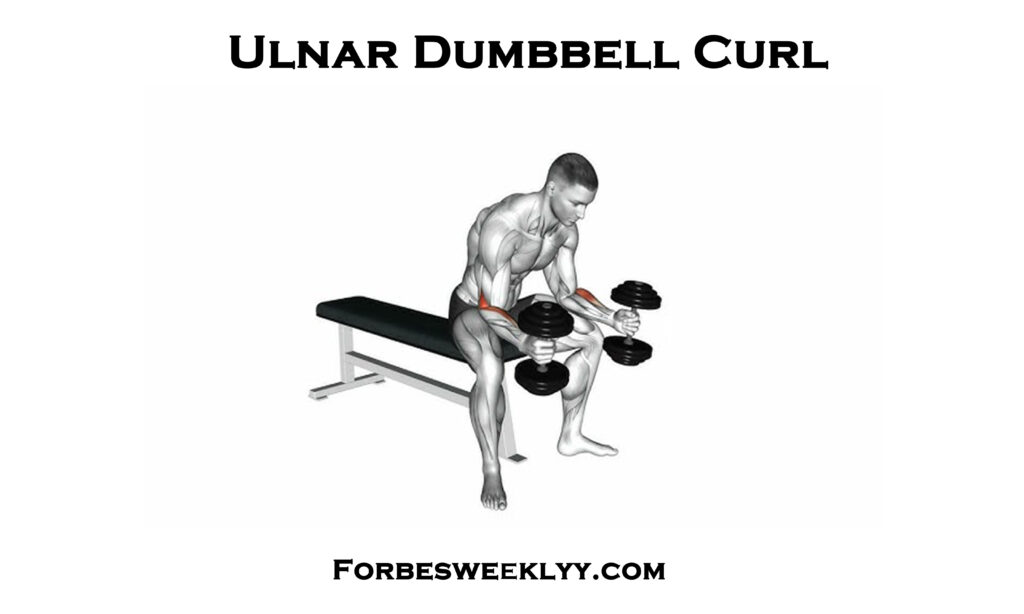To Highlight the principle of working on the muscles of the forearm, the ulnar dumbbell curl is one of the most effective and least known exercises. Although there are numerous users that prefer the bicep and tricep workouts, the ulnar dumbbell curl is effective for strong and practical forearm workout. This guide shall enthrall you with all factual data you could wish to know more about about the UDC such as the gains and the correct manner of performing the exercise ,moves or its variants and how you can possibly include the exercise in your training schedule.
How The Human Forearms Anatomy Is Organized
To better grasp the effects of the ulnar dumbbell curl it is fitting to reestablish the muscles implicated in forearm motility. The forearm consists of many muscles; however, some of the most essential are those that help in gripping and rotation of the wrist and the general movement of the forearm.
3 Main Muscles That Contribute to the Performance of the Ulnar Dumbbell Curl
1. Flexor Carpi Ulnaris (FCU): This muscle belongs to the forearm and is responsible for flexing and adding the wrist (moving the wrist towards the little finger side).
2. Extensor Carpi Ulnaris (ECU): Found on the opposite side of the forearm this muscle is generally used in extending the wrist together with its stabilization during operations.
3. Flexor Digitorum Superficialis and Profundus: These muscles are used mainly in finger flexion and these muscles are very useful when gripping the dumbbell during the curl.
4. Brachioradialis: It is a large muscle from the elbow to the wrist and draws the forearm backwards and is used in elbow flexor.
The UDC helps isolate these muscles, especially those that act on the wrist when it is flexed and deviated towards the pinky side of the hand.
What is the Ulnar Dumbbell Curl?
The ulnar dumbbell curl is similar to the regular dumbbell curl but places a lot of emphasis on the forearm muscles. As with other curls, this kind of exercise also involves the lower arm muscles but in a more profound way due to the variation in grip and wrist angle. This movement copies hand movement such as gripping surface and rotating, both of which are vital in sporting activities and in other basic activities within our day by day life.
Procedure of the Ulnar Dumbbell Curl
As with most exercises the position in which UDC is completed and ensures that the required muscles are being targeted is a mere shift in stance.
1. Start Position: Introduce the exercise by holding a dumbbell in one hand while either sitting or standing. The palm should be up or in supinated position, and the position of the wrist should be neutral when holding the dumbbell.
2. Grip the Dumbbell: Make sure that you keep your hand wrapped around the dumbbell. You are not putting too much stress on your wrist.
3. Curl the Dumbbell: Slowly turn the dumbbell up and bring it up by bending the elbow in such a way that it is at par with the shoulder level. At the same time, use your wrist to flex across to the pinky side (ulnar) side as you lift up.
4. Pause and Squeeze: At the peak of the movement, clench the forearm muscles for a brief second before carefully returning the dumbbell back to the initial position.
5. Repeat: W8-12R/S – As usual, execute the reps steadily and in a slow-moderate pace throughout the movement.
The next variation that differs in the performance of exercise is the UDC. When performing this motion, you work special muscles in the forearm that override the wrist and help in managing its flexion.
Common Mistakes to Avoid
1. Incorrect Wrist Positioning: Make sure that your wrist is progressively moving towards the ulnar side when you do the curl of the dumbbell. To prevent wrist stress, do not allow your wrist to rest in a postural neutral or in hyperextension position.
2. Using Too Much Weight: This exercise targets the smaller muscles of the forearm and should not be done with very heavy dumbbells that can cause poor execution.
3. Overextending the Elbow: Teach and encourage the students to keep folding their arm at the elbow so that the upper part, in the process of performing movement, does not become a burden to the biceps curl and there won’t be a possibility of the sudden muscle pull.

Some fresh pointers on the ulnar dumbbell curl
- Slow Down the Movement: The performance of this exercise requires slow and controlled reps in order to engage the muscles purposely.
- Engage Your Core: Even though the muscles targeted are those on the forearms, it will be beneficial to contract your abdominal muscles throughout the movement to help in proper posture.
- Use a Full Range of Motion: Make sure that you’re getting the maximum from each repetition by bringing the dumbbell up to the shoulder level and then stretching it down to the initial position again.
- Incorporate into Your Routine: The UDC should also be incorporated when you practice the curl exercises that target the forearms alongside wrist curls, reverse curls and hammer curls.
Liabilities of the Ulnar Dumbbell Curl
The ulnar dumbbell curl has these special features for anyone desiring to improve their forearm muscle power and grip, as well as, practical use. Let’s explore some of the key benefits:
1. Strengthens the Forearms
The UDC is designed to strengthen forearm muscles and increase the muscle capacity of a grip. This holds especially for athletes who need powerful forearm muscles for their activity, including climbers, tennis players and weightlifters.
2. Improves Wrist Stability
Due to its effects on the wrist flexion and ulnar deviation this exercise is effective in addressing the wrist instability. Strong and stable wrist joints are important for carrying heavy loads on the wrist, whether in the course of a given occupation or an arduous chore, to writing or typing.
3. Enhances Functional Fitness
The ulnar dumbbell curl is functional because the movement involved resembles that occurring in activities of daily living. Thus, the muscular strength developed through performing this kind of exercise will prove useful during grocery lifting or when holding some bags or engaging in sports.
4. Increases Grip Strength
A firm grip is an important part of practically every movement throughout daily life as well as high level sport skills. The ulnar dumbbell curl targets the grip muscles a lot and should thus be incorporated into any forearm workout.
5. Reduces Injury Risk
A good, well-developed forearm safeguarding muscle tissue offers protection to the body especially the wrist and elbow joints. The **ulnar dumbbell curl helps to develop a better muscle balance around the involved joints and will thus help to decrease the susceptibility of injuries such as strains or sprains during activities.
Modifications of the Ulnar Dumbbell Curl
Still this basic ulnar dumbbell curl is rather effective; however, there are some modifications for exercising the forearm muscles in different ways. Here are some popular variations:
1. Seated Ulnar Dumbbell Curl
In this variation, the individual performing the curl will sit down while they are doing the reps. Sitting enables controlling the movement of the dumbbell and also prevents them from using momentum to lift it.
2. Incline with UDC
The same curl is done with the back of the bench slightly raised, in order to work different parts of the forearm. Further, this variation aids in the elevation of the range of variation while placing effective emphasis on the frontal forearm area.
3. Hammer Curl to Ulnar Curl
First perform a basic hammer curl then when at the top of the movement turn your wrist into the ulna position for the second half of the curl. This variation gets the best of both hammer curls and **ulnar dumbbell curls** in order to give the forearm muscles a more effective twist.
How to Use The UDC In Your Training regimes
The ulnar dumbbell curl exercise is according to other movements on the forearm. Here’s an example of a forearm workout routine that incorporates the ulnar dumbbell curl:
Sample forearms workout regimen
1. Wrist Curls: 3 sets of 12-15 reps
2. Reverse Wrist Curls: 3 sets of 12-15 reps
3. Ulnar Dumbbell Curl: 3 sets of 8-12 reps
4. Hammer Curls: 3 sets of 10-12 reps
5. Farmer’s Walk: 2 sets of 30-45 seconds
Swallowing involves coordinated movements of the front and back forearm muscles, therefore, by including several ‘’types’’ of movements, you’re developing balanced functionality.
Conclusion
The ulnar dumbbell curl is another orthopractic exercise that does not require as much recognition as the other ones but has many benefits, particularly for the forearm muscles, the strength of the wrist and, of course, the grip. Including this movement in your exercise regimen allows for the conditioning of the specific regions in the forearm that form part of the functional and performance muscle types. Always start with correct posture and slowly click up the degree of difficulty. To sum it all, whoever you are, an athlete in practice, an amateur, or any person who wants to tone up their forearms, the ulnar dumbbell curl is something that should not be left out of your fitness training.
—
FAQ: Ulnar Dumbbell Curl
1. Which muscles does the UDC engage?
The ulnar dumbbell curl mainly exercises the flexor carpi ulnaris, extensor carpi ulnaris, and the rest of the forearm muscles that cause flexion at the wrist and deviation towards ulna.
2. Is there a way to train both arms at once on the ulnar dumbbell curl?
As with most of the movements in the ulnar dumbbell curl, you can perform it with one arm at a time, but if you’re short on time, you switch back and forth between arms. On the same note, exercising only one arm provides better form and more concentration to the working muscles.
3. How frequent is it to do the ulnar dumbbell curl?
It is best practice to do the ulnar dumbbell curl twice or thrice a week at the least with a day break in between.
4. Is it possible to dumbbell curl with heavier weight for the ulnar dumbbell curl?
To avoid compromising the form, it is advisable to use weight of a moderate intensity at the beginning. Gradually increase the weight as your forearm strength improves, while it will be beneficial to avoid the use of a very heavy dumbbell so that form is compromised and injuries are sustained.


